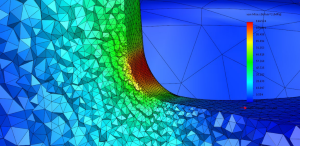How to Improve Data Management Workflows in Simulation Workflow
 With the advent of the Internet of Things and everything that comes along with it (including smart products and 3D printers) the way that companies do business and manufacture their products has become increasingly reliant on technology, and by extension, the data that powers and is produced by it. Designers and engineers creating products can leverage tools like 3D CAD and simulation software to create realistic models of their work, but with that comes even more data to manage. Fortunately, tools like SOLIDWORKS Simulation have begun to integrate capabilities that make it easier for users to better connect their CAD and simulation environments.
With the advent of the Internet of Things and everything that comes along with it (including smart products and 3D printers) the way that companies do business and manufacture their products has become increasingly reliant on technology, and by extension, the data that powers and is produced by it. Designers and engineers creating products can leverage tools like 3D CAD and simulation software to create realistic models of their work, but with that comes even more data to manage. Fortunately, tools like SOLIDWORKS Simulation have begun to integrate capabilities that make it easier for users to better connect their CAD and simulation environments.
What is SOLIDWORKS Simulation?
SOLIDWORKS Simulation is an analysis tool with a full integration that eliminates redundant tasks, shortens the learning curve, and allows users to test products for real-world performance. The simulation workflows within software like SOLIDWORKS Simulation gives designers the opportunity to compare design options and predict failures before 3D printing their models, saving them both time and money in the overall design cycle.
How Does SOLIDWORKS Simulation Improve Simulation Workflow?
SOLIDWORKS Simulation’s strength lies in its ability to set up an intellectual framework that can be incorporated into the simulation workflow. By joining CAD files and simulation data, designers can create a more collaborative environment that helps the different departments within an organization to improve their assessments and the security of their data. The key is to not only manage the data but to store and retrieve it in a way that makes it searchable to users.
What Are The Benefits of a Simulation Workflow?
As we mentioned, one of the biggest advantages of a simulation workflow like the one found in SOLIDWORKS Simulation is the speed it offers its users when managing and using data. In such a competitive environment, engineers and designers need to be able to create viable products as quickly as possible in order to make informed business decisions. Failure to do so could not only make development more time-consuming but also hurt the company’s bottom line.
The intelligent framework also makes it easier for users to see why and how decisions were made, improving visibility for everyone involved in the design process. The end result is faster and more effective communication across departments.
Related Articles
SOLIDWORKS Simulation 2019: Nonlinear Pins & Topology Study
Optimize Your Designs While Cutting Costs with SOLIDWORKS Simulation Tools
Simulation with SOLIDWORKS: Is it Enough?
About the Author
 Christa Prokos is a marketing manager at Fisher Unitech. She researches and writes about the latest business trends and technologies impacting manufacturers, including 3D printing, SOLIDWORKS 3D CAD design and product data management tools, product lifecycle management, virtual reality, and the Internet of Things. Christa has worked as a high tech marketing and communications professional since 2000.
Christa Prokos is a marketing manager at Fisher Unitech. She researches and writes about the latest business trends and technologies impacting manufacturers, including 3D printing, SOLIDWORKS 3D CAD design and product data management tools, product lifecycle management, virtual reality, and the Internet of Things. Christa has worked as a high tech marketing and communications professional since 2000.

 Blog
Blog